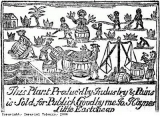The development of the plantation system
The Europeans settled in the Caribbean and on mainland America. The Spanish settled Jamaica, Cuba and Hispaniola, amongst other islands. In 1607 the English established a colony on the east coast of America, named Virginia. In 1623 and 1625, they settled the islands of St Kitts and Barbados in the Caribbean. In 1655 the British took the island of Jamaica from the Spanish. Admiral Sir William Penn, from Bristol, led the British naval attack that captured the island.
The original idea behind the settlement of the islands was to give land to small European farmers who would grow a variety of crops for export to Europe. At first the farmers grew tobacco and cotton. Sugar soon started to replace these two as the main crop. It was possible to make a good profit from sugar. But sugar needed a large amount of land and an investment in machinery to process the crop. So the small farmers were pushed out as farms were bought up to make large plantations for growing sugar.
Tobacco and cotton could be grown by a farmer with help from a few farm workers. The local peoples had been all but wiped out by the first European settlers. So farm workers were brought from Europe. On the British islands, these workers were indentured servants and convicted prisoners. Indentured servants were men and women who agreed to work for a given number of years for a fixed wage, their board and lodging and the cost of their journey out to the islands. Convicted prisoners could be transported to the plantations for a fixed term, instead of being hung or jailed in Britain.
This system did not supply enough workers as the tobacco farms became sugar plantations. Sugar needed a large number of workers. The Portuguese had been using enslaved Africans to grow sugar in the Madeira Islands (in the north Atlantic Ocean) since about 1460. Africa was closer to the Caribbean than Europe was. The African climate was similar to that of the Caribbean. Many African peoples were farmers. Europeans argued that the so-called ‘uncivilised’ African was hardly human. This sort of thinking allowed the inhumanity of slavery to be dismissed. They thought that if the slaves were not human, then they could not be treated inhumanely. Therefore, Africa seemed the obvious place to go for labour for the sugar plantations. As John Pinney, a plantation owner on the Caribbean island of Nevis, wrote in a letter of the 1760s: “I was shock’d at the first appearance of human flesh for sale. But surely God ordain’d ‘em for the use and benefit of us: otherwise his Divine Will would have been made manifest by some particular sign or token.”
The transatlantic slave trade began in earnest. Before this, small numbers of Africans had been kidnapped or bought by Europeans and taken to Europe or to European-owned islands. But as the growth of the sugar plantations took off, and the demand for labour grew, the numbers of enslaved Africans transported to the Caribbean islands and to mainland North and South America increased hugely.
On the Caribbean island of Barbados, in 1643, there were 18,600 white farmers, their families and servants. There were 6,400 African slaves. By 1724 these numbers had changed dramatically. There were 18,300 whites, and 55,206 African slaves.





